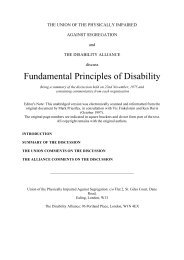Global-Report-Living-Colour-dr2-2
Global-Report-Living-Colour-dr2-2
Global-Report-Living-Colour-dr2-2
Create successful ePaper yourself
Turn your PDF publications into a flip-book with our unique Google optimized e-Paper software.
120<br />
Inclusive Communities = Stronger Communities<br />
GLOBAL REPORT ON ARTICLE 19: THE RIGHT TO LIVE AND BE INCLUDED IN THE COMMUNITY<br />
AUSTRALIA “Governments are not<br />
being held accountable for what they<br />
have agreed to under the CRDP. There<br />
are not “a lot of votes” in the provision<br />
of disability services, and little pressure<br />
from the public to deliver or improve<br />
disability services. Many people with<br />
disabilities and their families and carers<br />
do not have a strong voice to influence<br />
the delivery of services. There is an<br />
important place for campaigns and<br />
external advocates to hold governments<br />
accountable and to raise awareness of<br />
people's needs and rights.”<br />
advocates are often given little or no choice in<br />
housing options, often being referred to seniors’<br />
residences, nursing homes, and/or other<br />
inappropriate long term care settings. Additionally,<br />
the size of these settings also continue to grow as<br />
governments cut back spending in the social sector.<br />
‰ Something is Better Than Nothing<br />
In many countries, particularly low income countries<br />
where community supports and services to families<br />
and individuals are minimal or nonexistent<br />
institutions are being considered as a legitimate<br />
response to the critical need for support services.<br />
Sometimes, due to cultural issues, but more often<br />
because no other services are available or being<br />
offered, families mistakenly see this offer of<br />
institutional care as a step forward.<br />
‰ Services as Outcomes<br />
Many deinstitutionalization processes still measure<br />
success in terms of the number of buildings closed,<br />
placements made, and residential options created.<br />
Doing so however confuses “tools” with outcomes.<br />
The closure of an institution is not the goal; it is<br />
merely the result of assisting people to take their<br />
rightful place in community. If in helping<br />
people leave an institution we do not ensure<br />
that they have meaningful lives in community,<br />
then the process is seriously flawed. Many<br />
countries continue to rely almost exclusively on<br />
traditional residential models such as group<br />
homes. Yet a move to a group home is a<br />
“success” only if it provides a vehicle through<br />
which the person can create for themselves a<br />
meaningful and participatory life in community.<br />
Experience has taught us that options such as<br />
group homes, while an expedient tool to assist<br />
in the deinstitutionalization process, do not<br />
necessarily enable meaningful lives in



